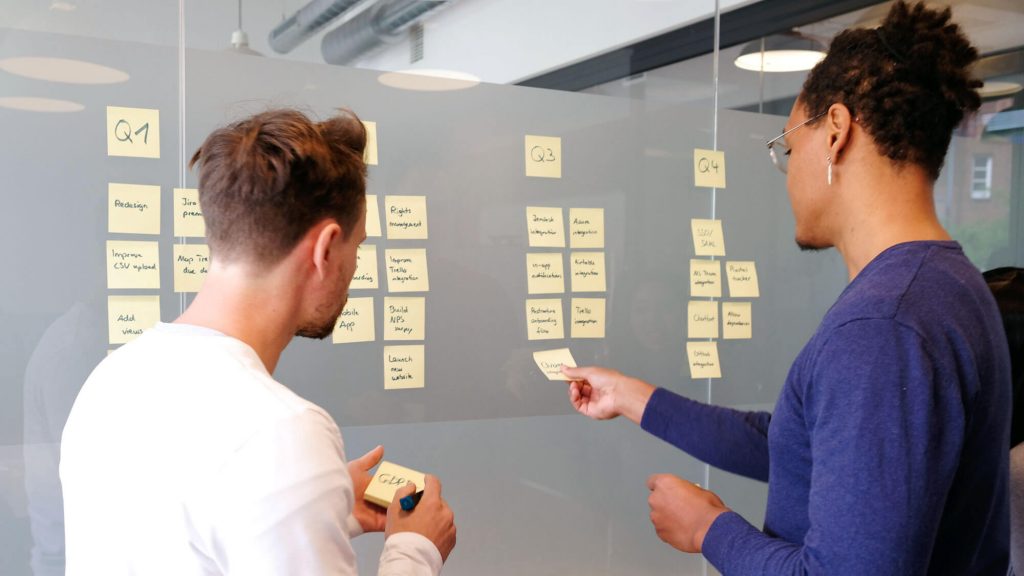How to Properly Leverage Kanban Boards

GUEST POST from Dainora Jociute
Whether it’s a bunch of sticky notes on an office wall or a clever digital tool with color-coded boxes, most of us are familiar with the ingenious concept of a Kanban board.
Perhaps that’s not the name you use. Maybe for you and your team, it’s Trello or simply a whiteboard, yet at the very core of it all, hides a little neat Japanese invention that sparks joy – Kanban.
It is not exactly a new concept, however over the years Kanban remains largely unchanged and its popularity unwavering. In this article, I will try to take a deeper look at what it is and how to make it work for you.
A Short History of Kanban
The word Kanban translated from Japanese means sign or signboard. Back in the day, and I am talking way back – 17th century – that was exactly what Kanban was. It was a signboard signaling to passersby what services or products a business offered.
In a more recent chapter of history, in the wake of the Second World War, the Japanese automotive manufacturer Toyota was in a pickle. The company struggled to make any profit, and they realized that something must be done. This is where Taiichi Ohno, the so-called founding father of Kanban comes into the picture.
A budding industrial engineer, Ohno was sent to the US to scout and gather inspiration for improving manufacturing back at the Toyota plant. The revelation hit Ohno in the most inconspicuous place – a grocery store. He noticed that some supermarkets stocked their shelves based only on customer demand. Customers would pull products they need off a shelf, and the store would restock them only once it was gone, avoiding unnecessary overloading of the shelves with excess products in advance. This system ensured that the store only sold products with real demand.
This pull approach (on that a little later) clearly reduced waste: it saved the time wasted on restocking, resources spent on overproduction, produce thrown out, and much more. Aiming to eliminate waste without sacrificing production back at the Toyota plant, Ohno introduced the pull system in the shape of paper cards that he later named Kanban.
Each Kanban card contained a clear description of each step in the production line, be it the number of materials needed or a particular task of the production chain to be done. It controlled amounts of production ensuring that only what is needed will be created. These cards moved systematically along the whole manufacturing process and guided what must be done throughout the journey. It became a simple yet ingenious tool for managing the whole manufacturing process ensuring that no waste will be created along the way.
Later down the line, other brilliant minds realized that the same approach can be applied to other industries too, not just manufacturing.
One of the key figures responsible for this adaptation was David J. Anderson. He is known for adapting Kanban principles from their origins in manufacturing to knowledge work, particularly software development and project management.
Although there were other prominent advocates of Kanban in software development, Anderson’s 2010 book on Kanban gained significant popularity, leading him to gain widespread recognition as one of the main proponents of the Kanban we all know today.
What is Kanban?
With all that said, it is time to go into more detail about what Kanban actually is.
In the simplest words, Kanban is a visual tool, a signboard for mapping and tracking planned work, work in progress, and work done.
Kanban is a visual tool for mapping and tracking planned work, work in progress, and work done.
While Toyota mainly used the original Kanban system to track inventory in their manufacturing processes, today’s Kanban can be applied to a much broader range of work areas.
Today, Kanban is widely used in knowledge work to visualize and map the value stream. It helps teams and individuals self-organize and minimizes the need for constant supervision.
However, it takes a bit of time to reach that harmonious sync with your team and squeeze the full value from the board. There are key things in the process that should be known before kicking one off, so let’s break the Kanban down.
Kanban, the Pull System
Now, you read it in this article and most likely you heard it before: Kanban is based on the pull process. But what does that entail?
In Kanban, the concept of “pull” means that tasks or projects are pulled into the process based on the team’s skills, readiness, and capabilities. Similarly, to the pull that Ohno observed in American grocery stores, in Kanban, you take action when there is a need and capability. This approach ensures that tasks are not imposed on individuals who might not have the time but are instead taken up by those who are more likely to complete them.
This enhances efficiency and effectiveness, prevents bottlenecks, increases the completion rate, and prevents waste. In the end, by pulling tasks based on readiness, the team can maintain a sustainable workflow and deliver outcomes within the expected timeframe.
Elements of the Kanban Board
When it comes to Kanban, the true beauty hides in its simplicity, and here, less is truly more. All you need is just a few elements to have a working Kanban board:
- Column: an element indicating the stage of the process (most commonly to be done, doing, and done.
- Card: an element visually representing a work item. This is where you write what has to be done, when, how, and who is responsible for it.
- Work-in-progress (WIP): a number indicating the number of tasks in the respective column. Having a WIP limit set for each “active” column helps with workload management.
- Swimlane: horizontal lines that split the columns, used to indicate the team responsible for the tasks, urgency, or just differentiate other relevant categories. The swimlanes are particularly useful for larger projects that involve multiple departments.
- Commitment point: a step in the process that signals when a task is ready to be taken to the next step of the development process. For example, when a team member selects a task from the backlog and moves it to the next column, the task crosses the commitment point. This means that the responsible person is committed to completing the task to the best of their knowledge.
Kanban Board

In addition, it is worth knowing the following definitions:
- Cycle time: This is the time need to complete a work item or progress a card from the backlog to the done column. Cycle time starts from the moment the work item crosses the very first commitment point and ends at the moment the work item is completed. It measures the actual time spent working on a task and is an essential metric for understanding how long it takes to complete individual items within the workflow.
- Lead time: It is the total time taken for a work item to move through the entire workflow, starting from the moment it is requested or initiated until it is completed and delivered to the customer. It includes not only the time spent actively working on the task (cycle time) but also any waiting time or delays while the task is in progress or in queues.
Cycle time measures the actual time spent working on a task.
Lead time measures the whole time spent on a task, both active work time and inactive waiting time.
These elements, paired with a clear process policy are all you need for the Kanban process to work.
How to Make Your Kanban Work
So, while the elements of Kanban are simple and straightforward, the success of the Kanban process and results heavily depend on the implementation of policies and effective communication practices.
There are a few of those that should be set in place before you start your Kanban initiative:
- Process policies. Essentially, this is a set of rules, guidelines, and agreements that will define how work needed to be done will be executed by the team. Having policies set before you start managing projects with Kanban will ensure that the team knows how to handle different types of tasks, and how to tackle possible issues along the way, it will assist in prioritization of work. Process policies act as the standard of your Kanban process.
- Commitment. Tasks should not cross commitment points because a member was bored or had extra time on their hands. Goals and expectations for each task should be communicated clearly. Assigning a responsible department or team for certain tasks helps to keep track and ensure that tasks remain in competent hands.
- Defined workflow. This refers to the specific stages (columns) through which work items move as they progress from initiation to completion. By defining your workflow in Kanban, you create a clear and visible representation of how work progresses through your process. This allows everyone to have a shared understanding of every step involved and the sequence of work.
- Limited WIP. It is a crucial aspect in reducing the cycle time for each project. By placing a cap on the number of tasks in progress, teams can allocate their capabilities and resources more effectively, avoiding the inefficiencies of multitasking. Having a smaller number of WIPs enables rapid identification of bottlenecks and prevents overburdening the team.
- Feedback. It helps to make iterative adjustments to optimize workflow, catalyzes learning, and promotes a culture of continuous improvement. Feedback in the Kanban process can be provided in many different ways, for example, daily stand-up meetings or code reviews done after the work item moves to a respective column (i.e. from doing to testing).
Benefits of Using the Kanban Method
Kanban is flexible, easy to use, and quick to master and there are plenty of benefits of using the method. To name a few:
- Workflow visualization. Visualization allows transparency, immediate feedback and real-time updates. And Kanban is an excellent way to visually represent and manage workflow, no matter how simple or complicated it is. By visually breaking down the process into small steps and putting it on a board, you can get a great view of who is working on which tasks and the overall progress of your project.
- Improved communication and collaboration. The possibility to see everyone’s progress with each task and who is responsible for what fosters more transparent communication. Regular meetings and check-ins on the board allow teams to provide feedback and leave comments. Knowing who is responsible for certain tasks improves collaboration by making it easy to give feedback or suggestion.
- Bottleneck identification. By leveraging the visual nature of Kanban, teams can proactively identify and address bottlenecks in the workflow. This helps optimize the flow of work, reduce delays, and increase efficiency and productivity.
- Reduced waste and increased productivity. Kanban allows gathering information about the processes quickly and changes might be made on the spot eliminating time for rework needed. Visualizing work and identifying bottlenecks enable streamlined processes, while work-in-progress limits prevent overload, leading to faster task completion.
- Continuous improvement. All the best aspects of Kanban culminate in Continuous Improvement. It is the most significant benefit of using Kanban in project management. With a clear and visual representation of the workflow, teams can easily identify areas in need of improvement and address issues quickly. By making incremental changes based on real-time feedback, teams can enhance their workflow, deliver higher-quality outputs, and be more responsive to customer needs.
The transparency provided by Kanban fosters a culture of ongoing optimization, making it an amazing tool for driving continuous improvement.
From Sticky Notes to a Digital System
Some years back, I worked in a company where we used a real, physical Kanban board. And I don’t mean a whiteboard, I mean a full wall, covered from top to bottom in sticky notes (big organization, big team, and a huge process). And part of me loved it.
We all worked like busy bees, with our individual tasks, tied to a common goal. Kanban was the place where everything fell into place.
Every morning we would hover over that wall, with a cup of coffee in our hands, checking where those stickies are traveling. It was a whole story unfolding in front of our eyes.

However, everyone agreed that tracking each sticky note took a big bite of our mornings.
Was the task I worked on approved by legal and moved to the next stage, or was it sent back to be reworked?
That’s why I see the digitalization of Kanban as a blessing. It makes things easier to track and increases readability, which reduces waste.
Also, think about the analytics and reporting. Our manager used to take pictures of the wall and show them during the Monday team meetings. Zooming and deciphering individual handwriting… yeah, not the best. Luckily, digital tools save us from this burden.
Pros and Cons of Digital Kanban Board
There are some obvious benefits of a digital Kanban board:
- Remote collaboration. Digital Kanban provides coherent communication and coordination among distributed teams. The team can access the Kanban board from anywhere, enabling real-time updates, tracking, and smooth communication. This fosters a sense of unity and efficiency, even when team members are geographically dispersed, ensuring that projects move forward cohesively and productively.
- Security. Digital Kanban tools often provide encryption and secure data storage, protecting sensitive information from unauthorized access, and in case of unexpected issues, you can often rely on automatic data back-ups and easy data recovery. Finally, such tools eliminate the risks of post-it falling off, being removed without a trace or simply getting damaged. In addition, it allows you to keep all the possible sensitive data hidden away from the curious eyes of office visitors.
- Automation. Most of the tools come with certain automation features. For example, notifications and email reminders ensure that Kanban stays active, deadlines are not forgotten, or finished tasks progress automatically. All relevant data is just a few clicks away, and integration with other relevant tools makes reporting and process improvement much easier.
- Document management. Most digital tools provide one safe and easy-to-access place to gather information, supporting files, and leave comments and feedback by the team.
- Customization. Most of the tools allow flexible customization, you can adapt the Kanban to your unique workflow, limit WIPs, add swimlanes, or add additional columns. As a secondary bonus, customization gives a chance to create a visually appealing board or a board that perfectly fits your brand.
However, as with most tools, there is no one right way. Digital Kanban tools has some disadvantages too:
- Lack of communication. Digital tools allow us to check information when we want, from wherever it is comfortable for us, meaning that we can finish the whole process barely ever meeting our team.
So, without a physical board, people might end up working in isolation. While it might sound like a dream for an introvert, in the grander scheme of things, lack of communication might cause an array of issues like misunderstandings, misalignment, delayed issue resolution, and others.
- Unfiltered input. The digital board might open the gate to idea dumping. While shooting as many shots as possible can be a good thing in a brainstorming session, only planned and discussed tasks should end up on a Kanban board to ensure that planned projects are finished efficiently.
- Dependency on third-party vendors. Using digital tools means relying on third-party vendors, and if the vendor faces issues or discontinues the product, it could disrupt the team’s workflow.
With that said, if you will look deeper into the pros and cons of digital vs physical, you might find a lot of contradicting information. Some articles might argue that digital tools can be time-consuming, requiring people to navigate additional applications, while others claim that physically going to a board might take extra time.
Similarly, some articles highlight concerns about communication issues and working in silos, whereas others praise digital tools for facilitating communication, especially among remote teams. The contrasting viewpoints can lead to different interpretations and opinions on the impact of digital tools in the workplace.
So, physical, or digital? As predictable as my answer will sound – it all depends on your unique way of working.
Going Digital
There are a lot of tools that could be used as a digital Kanban board. From the good old Excel to a dedicated digital Kanban tool such as Kanbanize, you have plenty to choose from. However, such tools are not necessarily equal to one another. If you were to take the digital route, here are some points worth considering before committing:
- Integration: i.e.: does the tool work with systems and other tools you already use?
- Visualization: i.e.: does the allow easy visualization of the workflow?
- Customization: i.e.: can you change and add elements as columns, WIPs, etc?
- Automation: i.e.: are you able to get reminders, or do finished tasks move automatically to the next column?
- Analytics: i.e.: can you extract data on cycle time or lead time?
- Ease of use: i.e.: how steep is the learning curve?
- Price: i.e.: does additional features, like the number of users, or analytics cost extra?
Conclusion
Kanban has come a long way from its inception as a simple manufacturing process management tool to the project management tool that it is today. And while Kanban is often associated with development, software, Lean, Agile, and Scrum… do not get tricked. Kanban can be used to manage wide-ranging projects with multiple stakeholders and at the same time, it can be used to help with organizing and managing personal projects.
As discussed earlier, it is obvious that the simplicity, flexibility, ease of deployment, and effectiveness in visualizing workflows, promoting collaboration, and continuously improving processes make Kanban an attractive tool for a variety of industries. It brings a myriad of benefits such as the reduction of bottlenecks, enhanced productivity and efficiency, improved communication and so much more. So, it is a no-brainer when it comes to giving Kanban a shot.
As to why it remains mostly unchanged, the good old rule of if it ain’t broke, don’t fix it applies here perfectly. From the 1940s to 2023, from automotive manufacturing to software development, Kanban has been and still is a simple tool that simply works.
Image credits: Viima, Unsplash
 Sign up here to join 17,000+ leaders getting Human-Centered Change & Innovation Weekly delivered to their inbox every week.
Sign up here to join 17,000+ leaders getting Human-Centered Change & Innovation Weekly delivered to their inbox every week.

![]() Sign up here to join 17,000+ leaders getting Human-Centered Change & Innovation Weekly delivered to their inbox every week.
Sign up here to join 17,000+ leaders getting Human-Centered Change & Innovation Weekly delivered to their inbox every week.









